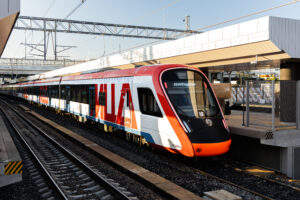As cities around the globe seek innovative and sustainable transportation networks, the MCD offers a vision of the future, showcasing how urban mobility can be reimagined. Moscow’s pioneering initiative aims to establish a surface metro system that seamlessly integrates the vast Moscow agglomeration, setting a gold standard for urban transportation solutions

KUALA LUMPUR, 29 August 2023 – Moscow proudly launched its third Moscow Central Diameter (MCD-3), marking a remarkable stride in the arena of urban mobility not only for Russia but also on a global scale. This development underlines the city’s commitment to providing its commuters with efficient, sustainable, and modern transportation.
Inaugurated by Russian President Vladimir Putin and the Mayor of Moscow Sergei Sobyanin, the MCD stands as a monumental project in global passenger transportation. Its inception aimed to establish a surface metro system to seamlessly interconnect the vast Moscow agglomeration. A testament to its success, within just two years from its establishment, the MCD witnessed the launch of its first two diameter sections on November 21, 2019. Since that milestone, the MCD has served over 600 million passengers, echoing its undeniable significance and efficiency.
MCD-3 is bridging districts with an enhanced commuter experience
The newly launched MCD-3 is a colossal 85 km-long railway stretch bridging the northwest and southeast districts of Moscow. The line already features 38 operational stations, with the addition of 3 more – Mitkovo, Malino, and Rizhskaya – anticipated soon. Catering to an impressive 3.5 million residents, MCD-3 connects 24 districts within Moscow and an additional 4 districts in the encompassing Moscow region.
One of the salient features of the MCD-3 is its integration with 21 transit connections, inclusive of the prominent Big Circle Line and the Moscow Central Circle (MCC). This synergy is projected to alleviate the congestion of three existing metro lines by up to 15%. Furthermore, the successful operation of the MCD-3 promises a notable reduction in road traffic, estimating a daily decrease by nearly 7,000 vehicles. This initiative aligns with Moscow’s vision for a greener environment, aiming to slash harmful emissions by up to 36,000 tonnes annually.
Enhancing the overall travel experience for commuters, the MCD-3 has dramatically increased its daily passenger capacity from 0.9 million to a staggering 1.9 million. This ensures that travellers can enjoy a more comfortable and spacious commute, even during peak hours. Furthermore, with service frequencies rising by 1.5 times, travellers will only experience a minimal 5.5-minute wait between trains during high-traffic hours. This enhanced efficiency is complemented by a substantial reduction in transportation costs, potentially decreasing by up to 3.5 times for regular commuters.

Moscow is a vision of the future with a commitment to optimize travel experience
Adding to its technical prowess, the Mitkovskaya connection has been thoroughly refurbished. This initiative successfully connects previously isolated railway lines without causing any disruption to existing traffic. To further refine the passenger experience, the MCD-3 line will operate with a fleet of 11 Ivolga and 19 EP2D trains. Additionally, traditional suburban routes will soon witness a modern transformation, with plans to replace older trains by 2024. This initiative will ensure all long-distance suburban zones boast 100% modernized rolling stock. Presently, the MCD already prides itself on operating entirely with new trains.
Moscow’s ambition doesn’t stop here. The city envisions an array of future projects, with highlights including the introduction of the MCD-5 diameter section, enhanced connectivity between Moscow and its neighbouring major cities.